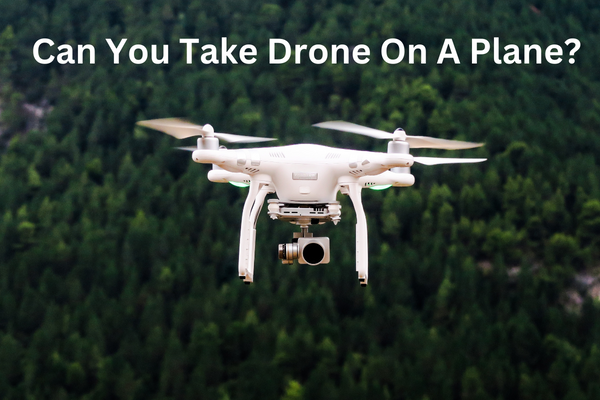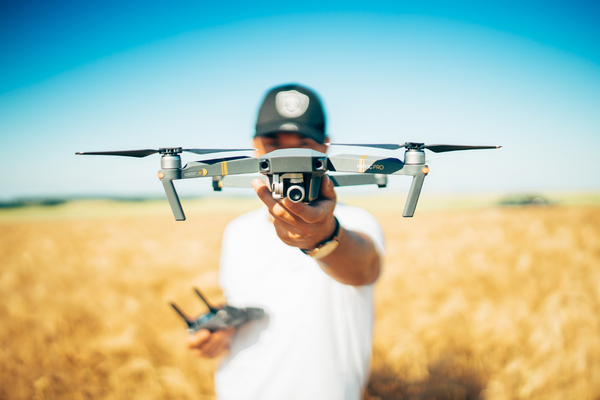Drones make excellent traveling or holiday companions since they can shoot spectacular photographs or films that will make your vacation experiences unique. Many drone owners can’t fathom traveling without their mini-planes.
You must have several questions popping into your mind, like whether you can bring drones on a plane. Or can you take drone on a plane?
Well, for your convenience, I have covered all your doubts and answered them in this article.
Page Contents
Can You Bring A Drone On A Plane?
When it comes to limiting customers from taking specific things on an aircraft, airlines are forced to obey TSA and FAA laws. Drones are permitted through airport security checkpoints by the TSA. While federal regulations do not prohibit the use of drones, individual airline rules differ.
In the United States, no airlines officially forbid the use of drones. Some airlines require travelers to transport drones in their carry-on luggage rather than checked baggage. Many other airlines let travelers transport drones as carry-on or checked luggage.
The TSA and the FAA can only regulate domestic flights. International flights may be subject to extra restrictions. For example, when visiting a foreign country, visitors must follow the target country’s laws. All drone operators in the Bahamas, including international tourists, must register with the authorities. Failure to register might result in the drone being confiscated.
Before flying an overseas flight with a drone, familiarise yourself with the target country’s drone rules and regulations. Traveling with a prohibited item may result in the seizure of the drone and the imposition of fines. The traveler may be denied entry into the nation as well.
How Do I Take a Drone on a Plane?
There are various processes involved in flying with a drone. First, the traveler should discover whether the airline’s regulations ban the use of drones in checked or carry-on baggage. If the drone is permitted on the flight, the traveler should study the airline’s restrictions regarding the transportation of LIPO batteries. In most circumstances, the drone and batteries will need to be carried on by the tourist.
When passing through the security checkpoint, travelers should tell TSA officers that they have a drone in their luggage. While the TSA permits drones, the presence of the gadget may generate a red alert when going through the scanner.
After checking airline restrictions, travelers should look for acceptable drone storage, such as a drone case. Drone cases are generally small, holding only the drone, the controller, and two or three batteries.
Always double-check the case’s measurements. The passenger may have to inspect the case if it is too large to be carried on. However, some airlines ban using drones in checked baggage, which may cause travelers issues.
The typical carry-on baggage size is 22x14x9 inches. Carry-on limitations differ per airline, as do other rules. Some airlines may only accept luggage no wider than 21 inches. Many airlines have a weight limit for carry-on baggage in addition to a size limit. The standard weight restriction is 50 pounds. However, some airlines only allow bags weighing up to 22 pounds.
How To Take Drone Batteries on a Plane?
Because most drones use lithium-ion (LIPO) batteries, you must adhere to FAA hazardous materials standards. LIPO batteries should be kept in your carry-on. You may be allowed to put them in your checked luggage in some circumstances; nevertheless, I feel that the restrictions for flying with lithium-ion batteries are simpler and easier to follow for carry-on baggage.
Carry-On Baggage
When carrying LIPO batteries in your carry-on luggage, you must know their watt hours (Wh).
Follow these steps when carrying LIPO batteries with 100 Wh or less in your carry-on luggage:
- To keep LIPO batteries from short-circuiting in your carry-on luggage, use any of the following methods: leave the batteries in their packaging boxes, cover the battery terminals with a strip, use a battery case, use a battery pouch in a camera bag, or pack them tightly in a Ziploc bag or protective pouch.
- The batteries you bring must be for personal use only—pack batteries for resale or vendor distribution only.
- Check with your airline to see if you need to pack LIPO batteries in your carry-on bag.
- Follow these rules when carrying LIPO batteries with more than 100 Wh but less than 160 Wh in your carry-on baggage:
- You must acquire airline authorization to bring a bigger LIPO battery (more than 100 Wh) onboard in your carry-on luggage.
- Pack no more than two extra batteries with more than 100 Wh capacity.
- To avoid a short circuit, keep batteries in their original packing, a battery case, or a separate pouch or pocket.
Checked Baggage
Only LIPO batteries with a capacity of 100 Wh or less can be transported within checked luggage if they are securely mounted inside the drone. The airline must approve LIPO batteries weighing more than 100 Wh before being placed in checked baggage.
You are not permitted to bring extra LIPO batteries of any Wh in your checked luggage. Only the batteries from your drone may be limited as luggage. Instead, bring spare batteries in your carry-on, and keep them in their original packaging, a battery case, or a discrete pouch or pocket.
Things To Be Aware of Before Flying With a Drone
- Batteries
If you’ve lately traveled someplace, you’ve probably realized that there are limitations to flying with batteries. The lithium-ion cells and lithium metal batteries that power our drones are classified as “Dangerous Goods” by the US Department of Transportation.
According to the FAA, “a dangerous good (also known as hazardous material or hazmat) is any substance or material that, when transported in commerce, poses an unjustifiable risk to health, safety, and property.”
Although this categorization may appear scary, it is merely because lithium-ion cells and lithium-metal batteries might endanger both the airplane delivering them and all of us. We’ve all seen movies of malfunctioning lithium batteries exploding or bursting into flames in mid-flight. That is not something any of us would want to experience directly.
- Size Limits
The capacity of lithium-ion (rechargeable) batteries is limited to 100-watt hours (Wh) per battery. These limitations allow practically all types of lithium batteries to be used in electronic gadgets by ordinary person.
Passengers may also take up to two spare bigger lithium-ion batteries (101-160 Wh) or lithium metal batteries with airline authorization (2–8 grams). This size includes aftermarket extended-life laptop computer batteries as well as sure bigger batteries used in professional audio/visual equipment.
- Quantity
None for most batteries; however, batteries must be for passenger use. Batteries transported for resale or distribution (vendor samples, for example) are forbidden. For the bigger lithium-ion batteries indicated above, there is a maximum of two extra batteries per user (101–160 watt hours per battery).
Taking Your Drone Through Customs
The country’s national or civil aviation authority usually creates and enforces drone laws. In the United States, for example, drone rules are regulated by the Federal Aviation Authority (FAA); in Canada, they are set by Transport Canada Civil Aviation (TCCA). Identifying the civil aviation authority in the nation, you’re visiting can assist you in learning about the drone legislation in that country.
I do not advocate carrying your drone to places where it is unlawful to fly one. It’s conceivable that your drone will be seized at customs. It may or may not be returned to you when you depart the country on your return flight.
You should not assume that you will be able to bring or operate your drone in nations where no drone rules have been developed. The lack of drone rules only sometimes implies that you may fly wherever and however you want, authorities may be generally hostile to the usage of drones, particularly by tourists.
The same warning applies when taking a drone through customs. When a nation lacks drone-specific legislation, some customs agents opt to take drones while others do not—but it’s nearly impossible to tell what you’ll encounter until you arrive with your drone.
As an added precaution for US tourists, you may be able to register your drone with Customs as a “Personal Effect Taken Abroad” before departing. This will eliminate confusion about whether you are returning with the same drone you left with or importing a new one acquired elsewhere.
What Countries Can You Not Fly Drones in?
Drones are now entirely prohibited in 15 nations. Arriving in one of these nations with a drone may result in a variety of outcomes, ranging from being denied entrance to having the drone confiscated.
Drones are prohibited in the following 15 countries:
- Algeria
- Barbados
- Brunei
- Ivory Coast
- Cuba
- Iran
- Iraq
- Kuwait
- Kyrgyzstan \sMadagascar
- Morocco
- Nicaragua
- Senegal
- Syria \sUzbekistan
The majority of these countries say that drones pose a security risk.
Some nations need registration in addition to a total ban on drones. Recreational drone flights require registration in the Bahamas, the United States, the United Kingdom, and many other nations in Europe, Asia, and Africa. Failure to register may result in drone seizure and penalties.
To fly a drone in practically every European Union (EU) member state, persons must first register with the Civil Aviation Authority. The operator obtains a unique registration number after registering. The registration numbers are saved in a database that each EU country’s aviation authority can access. This enables the registration to be recognized across the EU.
The EU criteria, like the FAA rules, are determined by the size of the drone. The drone operator is not required to register if the drone weighs less than 0.55 pounds. In addition, the EU demands operators observe extra restrictions, such as only flying in defined zones.
Drone legislation is constantly evolving. Some countries that presently prohibit drones may accept them, while others that currently permit them may eventually deny them. The most secure option is to thoroughly review the regulations of each stage of the journey, including the airline and the destination country.
FAQs:- Can You Take Drone On A Plane
Que:- 1. Can I take the drone in my hand luggage?
Ans:- You can transport them in either your hand baggage or your checked luggage (though without the batteries). Protected lithium batteries of up to 100 Wh must be carried on; however, if fitted in electronic equipment, they can be checked in.
Que:- 2. Can you take drones through airports?
Ans:- If your drone is small enough to fit in a piece of carry-on luggage, you must take it through airport security. When going through, you will be required to display your drone and its attachments, as with many other significant electrical devices.
Que:- 3. What are the rules for taking a drone on a plane?
Ans:- A drone can be taken on an aircraft as either carry-on or checked baggage, depending on its size. However, you must remove the drone’s batteries and place them in your carry-on bag.
This article helped you immensely in compiling the things you should remember before flying with drones. If you have any other concerns regarding carrying drones on a plane, let me know in the comments.
Safe Journey.




